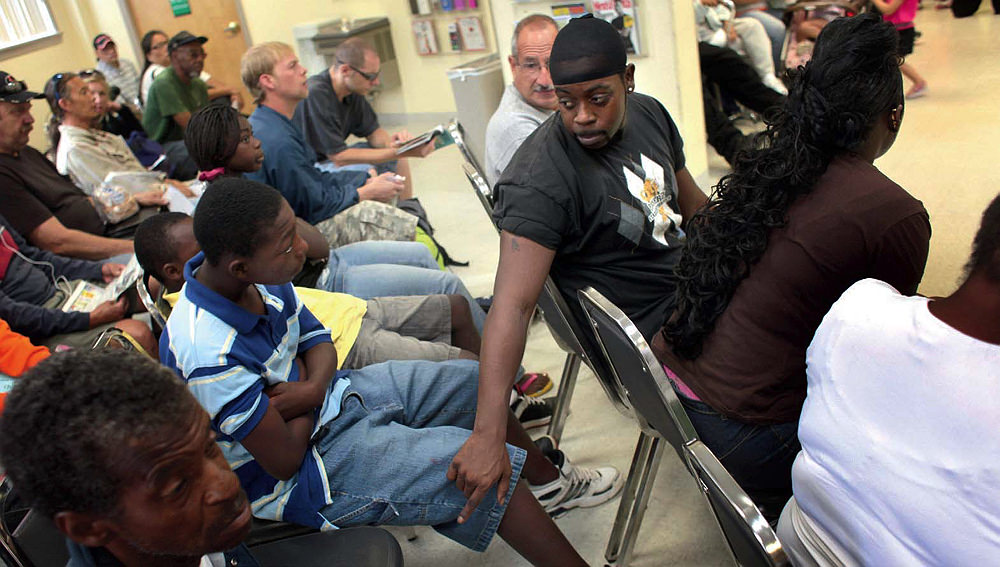LONG BEFORE the presidential primaries, or a paralyzing pandemic, Harvard Magazine asked several faculty experts to write about issues that would be shaped by the national elections, that mattered to the future of the country—and that would probably be addressed inadequately during the extended campaign.
One issue was the federal budget and its chronic, enormous deficits. When we approached Karen Dynan and Douglas Elmendorf to explain all that red ink (and what, if anything, to do about it), the state of play was an unlikely mix: a record U.S. economic expansion and very low unemployment, paradoxically accompanied by trillion-dollar annual deficits and historically low interest rates. Those figures now seem quaint. The coronavirus has caused a precipitous recession, or worse, and attempts to offset potentially cataclysmic job losses are yielding a multi-trillion-dollar budget gap that will need to be paid for some day; at the same time, government interest rates have fallen even further. In this context, Dynan and Elmendorf’s analysis is especially timely and relevant.
Spending on health care is central to the long-term budgetary challenges. So it is especially useful to pair their essay with David Cutler’s nuanced explanations of why American health care costs so much: about $3.5 trillion per year (that’s the norm, before an emergency like COVID-19)—of which one-third is wasted. The sources of that waste, in terms of health value received for dollars spent, may surprise you. It has certainly proven resistant to political repair. Given the relatively poor results Americans receive for all they spend, fixing health care matters: for citizens’ well-being, the country’s fiscal soundness, and extending essential medical services to those who lack access now.
Harvard Magazine presents these thoughtful commentaries as a service to readers—and as a contribution to better public debate. You can learn more from all three authors on their segments of the Ask a Harvard Professor podcast.
~ The Editors
* * *
Alec Smith died of diabetic ketoacidosis, though it is probably fairer to say that he died from high healthcare costs. The 26-year-old from Rochester, Minnesota, had just moved out of his parents’ home and didn’t have enough money to afford his insulin. He decided to ration his remaining supply until his next paycheck, a week later. Alas, he was not able to make it. Alec died alone in his apartment, vomiting and having difficulty breathing, from a condition that never should have occurred.
Alec’s story is extreme in its outcome, but not in its outlines. Nearly half of Americans say they have delayed or skipped medical care because of the cost. People who face higher costs for medical care are diagnosed with cancer at later stages of the disease and take fewer medications. Even the very sick use less care when their out-of-pocket costs rise. Health suffers.

A Medicare enrollee awaits a prescription in Chicago. The U.S. health system entails extraordinary administrative expenses.
Photograph by Tim Boyle/Getty Images
The United States has many problems in medical care, from the large share of the population still uninsured (about 10 percent of us) to one of the lowest life expectancies in the developed world. Underlying all these problems is the high cost of medical care. We do not guarantee adequate access to medical care because we cannot figure out how to pay for it.
The harm from high medical spending goes well beyond the medical sector. Many firms have outsourced low-wage workers because providing them health benefits is too expensive. Government spending for schools and environmental programs are starved because resources go to health care instead. Warren Buffett called medical costs the “tapeworm of American economic competitiveness.” Oncologists have invented a term, “financial toxicity,” to consider along with biochemical toxicity in deciding on the appropriate treatment.
Americans agree with Buffett. Two-thirds of Americans want the federal government to regulate the price of medical care. Indeed, the public has a clear theory for explaining high medical spending: unconstrained greed. Pharmaceutical companies put profits above patients, and insurance executives are paid millions to deny coverage. The government should stop both.
And people are right, to a point. Allowing the makers of life-saving medications to price their products without constraint is a recipe for premature death. But the issue is more complex than just greed. Even if the United States cut every pharmaceutical price in half and eliminated all profits on health insurance, the gap between U.S. medical spending and that of other rich countries would fall by less than a quarter. Health care is more than just rapacious profits in drugs and insurance.
The reality is that the healthcare problem is multifaceted. But that is not the same as saying nothing can be done. On the contrary, it means there is even more to do. Three areas are essential to tackle if we want to reduce health spending to near the level in other countries.
Administration Adds Up
The largest component of higher U.S. medical spending is the cost of healthcare administration. About one-third of healthcare dollars spent in the United States pays for administration; Canada spends a fraction as much. Whole occupations exist in U.S. medical care that are found nowhere else in the world, from medical-record coding to claim-submission specialists.
Healthcare administration needn’t be so costly. Even in other countries with multiple payers and private providers—including Germany and Switzerland—healthcare administration is less than half the cost of the U.S. equivalent. The key requirement for reducing administrative costs is standardization. Grocery-store checkout is simple because all products have bar codes and credit-card machines are uniform. Mobile banking is easy because the Federal Reserve has put standards in place for how banks interface with each other. But every health insurer requires a different bar-code-equivalent and payment-systems submission. And even in 2020, it is virtually impossible to send medical records electronically from one hospital to another. Almost all hospitals have electronic medical records, but there is no federal requirement that they interface. Indeed, many providers take active steps to avoid electronic interchange, because keeping records local ensures that fewer patients will switch doctors.
Standardization occurs when big participants decide they want it. In healthcare, the big participant is the government. Only the federal government has the buying power and administrative reach to force payers and providers to adopt billing and interface rules. The federal government could commit to a date by which all interactions are standardized and set up the infrastructure to make that happen. To date, however, the public sector has shirked its responsibility. The federal government sees its role as providing insurance to people—Medicare and Medicaid in particular—but not looking out for the system as a whole. That thinking will need to change if progress is to be made.
Greed and Gouging
Greed is the second part of excessive health spending. The U.S. list price for insulin is 10 times higher than that in Canada. Relief for Alec could have come after a short bus ride north. But pharmaceuticals are not the whole story. Prestigious hospitals charge multiple times what less prestigious hospitals do for the same service. While that may be justified in the case of complex surgery, it surely is not for an x-ray.
It is no mystery why pharmaceutical prices are higher in the United States than in Canada and at star hospitals as compared to community institutions. Prices rise when there is nowhere else to go. Traveling to Canada for insulin is not something most Americans can do—though Alec Smith’s mother now leads such trips, or did when she was able to do so. And few people are willing to switch from a star hospital to a community institution, even if the price is much lower.
Economists’ favorite solution to such “sticky” demand is to help people become more mobile. Play different insulin suppliers off against each other to bargain for a lower price. Have interactive websites to help people shop for lower-priced imaging. Alas, all attempts to make these policies work have so far been unsuccessful. Many employers have created websites where their employees can search for more and less expensive services. Uniformly, they find that raising costs to patients via co-pays and deductibles, for example,reduces utilization but engenders relatively little price shopping. It is not that people think the star hospital is necessarily better. Rather, their physician directs them there, and they are afraid to ask about cheaper alternatives. Pharmaceuticals are a partial exception. People will often choose generic drugs, if available, over a brand name—but they do not do so in sufficient amounts to materially lower the cost of drugs. And federal laws make it illegal for bulk reimportation of drugs from Canada. The result is that star hospitals are overflowing with patients, and insulin prices keep rising.
If prices cannot be tamed by demand, a growing number of economists call for price regulation. Fiat can accomplish what reasoning cannot.
Price regulation is not hard to implement: “Thou shalt not price higher than X” is not a particularly difficult rule to enforce. The state of Maryland does this for hospitals, and most European countries do this for pharmaceuticals.
The major challenge to implementing such a policy is the possible unintended consequences. If pharmaceutical manufacturers or academic hospitals got less money, what would they cut out? Would executive compensation fall (likely a good thing)—or would money for research and development dry up? We are not certain of the answer to this, and so regulation comes with a side dose of concern. That said, every example of a family afraid to visit the emergency department because of the cost, and thus waiting to see if a sick child gets worse, pushes the case for price regulation forward.
In Love with Medical Services
The final part of higher medical spending in the United States is higher utilization. The United States has the most technologically sophisticated medical system of any country, and it shows up in spending: the U.S. has four times the number of MRIs per capita as Canada, and three times the number of cardiac surgeons. Americans don’t see the doctor any more often than Canadians do, and are not hospitalized any more frequently, but when they do interact with the medical system, it is much more intensively.
Outcomes for this greater intensity are not easy to find. Despite the more intensive U.S. cardiovascular care, heart-attack survival is no better. Indeed, U.S. death rates for heart disease have been rising relative to other rich countries. The greater degree of imaging in this country detects more cancers, but many of these would never have become clinically apparent. Many cancers grow slowly, and often the patient dies of something else long before the cancer would have become noticeable.
And even as the United States overdoes high-tech care, it underprovides routine care. Effective medications to treat high blood pressure and high cholesterol have been around for decades, yet only half of people with these risk factors are successfully treated. Mental illness is underdiagnosed and undertreated despite its enormous social cost.
The reason for the disparity between high-tech and routine care is not hard to ferret out. Cardiac surgery and MRIs—famously lucrative—are overprovided, but no one is paid to make sure hypertensive patients take their medications.

An uninsured father and son at a health clinic in Denver. Lack of coverage persists for a significant share of the population.
Photograph by John Moore/Getty Images
Addressing the misallocation of medical resources is the most difficult technical challenge in lowering medical spending. How does one get a health system to perform fewer MRIs but do them on the right patients, and use the money saved to extend more primary care? The Canadian policy for overprovision is simple: limit the total amount of high-tech care available. Canadian governments ration the number of scanners that can be bought and how many hospitals can have open-heart surgery facilities. Within the available supply, physicians decide how the services are allocated. In a highly professional system like Canada’s, doctors perform the allocation rules very well. Thus, outcomes are better in Canada than in the United States, at a fraction of the cost.
The U.S. government once tried this type of technology rationing—it went by the name of Certificate of Need regulation. In the 1970s and 1980s, state governments had systems to approve each new scanner or addition to a hospital’s footprint and were supposed to say no when it was not necessary. But the policy was not very effective. Without a firm limit on what was allowed to be spent on medical care, it was too difficult for technology boards to deny hospitals. That set of policies has been left in the dustbin of failed cost-containment efforts.
Over time, insurers evolved other ways to try to restrict care. Some insurers have gone with a high cost-sharing strategy: make people pay more when they use care. Those willing to pay a higher cost can have the service. This is the strategy that leads to high out-of-pocket costs for insulin and emergency-department use. The second strategy is to keep an eagle eye on what physicians want to do, to make sure that all care is medically necessary. While good in theory, the administrative costs of this policy have proven to be a disaster.
The most recent economic idea is shared savings: don’t pay physicians a fee for each service, with higher rates for surgery and imaging than for medical management. Instead, set a target amount of spending for the average patient. If spending comes in below the target and quality is sufficiently high, the provider group gets to share in the savings. Thus, physicians have incentives to limit their own use of imaging to necessary cases and to figure out ways to extend primary-care practice. This policy was first tested in Massachusetts and has since gone national.
To date, there is no evidence that shared-savings programs will lead this country to the much lower Canadian or European levels of medical spending and better health outcomes.
The evidence so far is that shared savings programs have been modestly successful. Cost growth falls in shared-savings programs and quality seems to improve. But the savings are not as big as hoped for. To date, there is no evidence that shared-savings programs will lead this country to the much lower Canadian or European levels of medical spending and better health outcomes.
This discouraging record leads to deep questioning about how to make progress in medical care. Can the current system be a basis for good medical and economic outcomes, or must one make more radical change? Proponents of the latter view fall into two camps. On the left are those who reason that the only successful healthcare models internationally are single-payer systems, so the United States must move in that direction to do materially better. On the right are those who argue that only markets can provide the combination of price and quality that people want, so the country needs to remove government from the equation as much as possible. Not surprisingly, many Democrats espouse the former, and Republicans sign on to the latter.
In Rochester, Minnesota, and elsewhere in the country, people want none of this bigger debate. Phrases like “choice” and “single payer” are not helpful, let alone “incentives for interoperability of healthcare records.” Recall that Americans have a firm view of the problem: greed. Every conversation about something other than greed seems entirely beside the point.
This creates a special problem for the healthcare policymaker. In addition to figuring out what is technically correct, we need to learn how to explain those reforms to worried people. Can we promise that any policy will prevent deaths like Alec Smith’s and not harm people in other ways? Speaking morally, as well as economically, is the biggest challenge in health policy.








